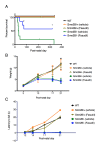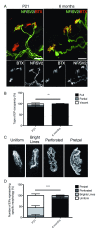Fasudil improves survival and promotes skeletal muscle development in a mouse model of spinal muscular atrophy
- PMID: 22397316
- PMCID: PMC3310724
- DOI: 10.1186/1741-7015-10-24
Fasudil improves survival and promotes skeletal muscle development in a mouse model of spinal muscular atrophy
Abstract
Background: Spinal muscular atrophy (SMA) is the leading genetic cause of infant death. It is caused by mutations/deletions of the survival motor neuron 1 (SMN1) gene and is typified by the loss of spinal cord motor neurons, muscular atrophy, and in severe cases, death. The SMN protein is ubiquitously expressed and various cellular- and tissue-specific functions have been investigated to explain the specific motor neuron loss in SMA. We have previously shown that the RhoA/Rho kinase (ROCK) pathway is misregulated in cellular and animal SMA models, and that inhibition of ROCK with the chemical Y-27632 significantly increased the lifespan of a mouse model of SMA. In the present study, we evaluated the therapeutic potential of the clinically approved ROCK inhibitor fasudil.
Methods: Fasudil was administered by oral gavage from post-natal day 3 to 21 at a concentration of 30 mg/kg twice daily. The effects of fasudil on lifespan and SMA pathological hallmarks of the SMA mice were assessed and compared to vehicle-treated mice. For the Kaplan-Meier survival analysis, the log-rank test was used and survival curves were considered significantly different at P < 0.05. For the remaining analyses, the Student's two-tail t test for paired variables and one-way analysis of variance (ANOVA) were used to test for differences between samples and data were considered significantly different at P < 0.05.
Results: Fasudil significantly improves survival of SMA mice. This dramatic phenotypic improvement is not mediated by an up-regulation of Smn protein or via preservation of motor neurons. However, fasudil administration results in a significant increase in muscle fiber and postsynaptic endplate size, and restores normal expression of markers of skeletal muscle development, suggesting that the beneficial effects of fasudil could be muscle-specific.
Conclusions: Our work underscores the importance of muscle as a therapeutic target in SMA and highlights the beneficial potential of ROCK inhibitors as a therapeutic strategy for SMA and for other degenerative diseases characterized by muscular atrophy and postsynaptic immaturity.
Figures







References
Publication types
MeSH terms
Substances
Grants and funding
LinkOut - more resources
Full Text Sources
Other Literature Sources
Medical

